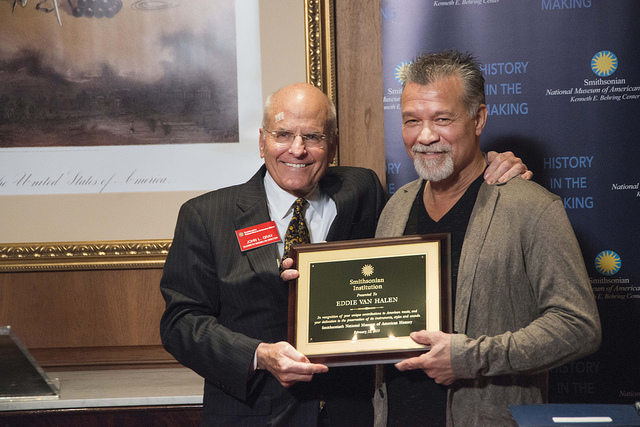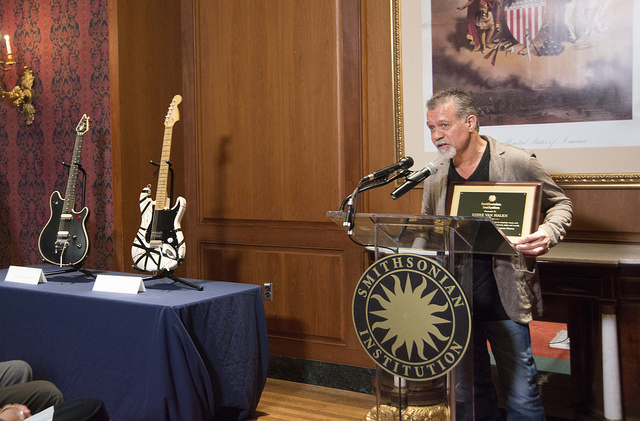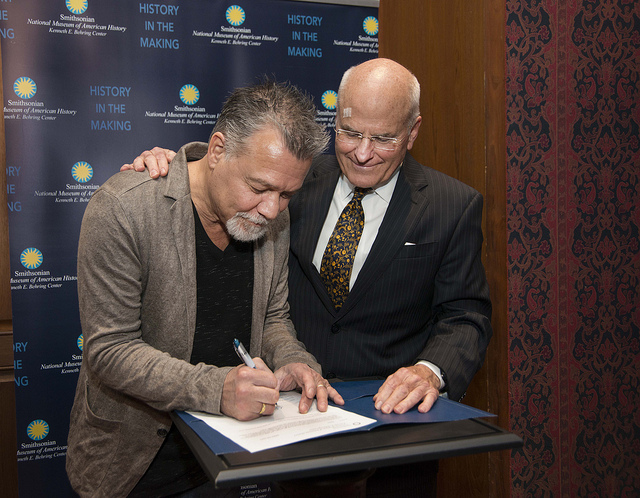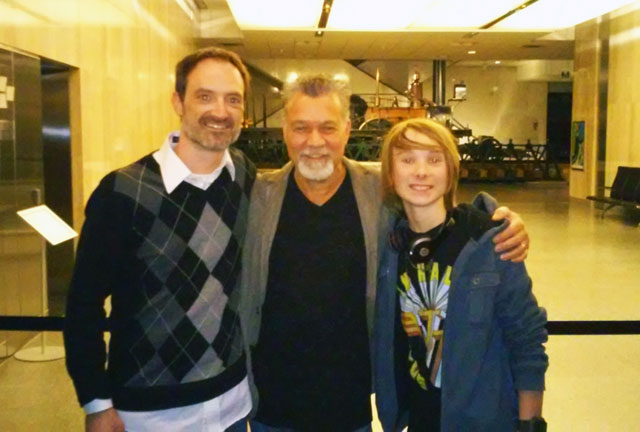
By VHND contributing writer Kevin Dodds, author of Edward Van Halen: A Definitive Biography
Photos by National Museum of American History Smithsonian Institution
On a bitter cold night in Washington D.C. on February 12, 2015, the atmosphere inside the Smithsonian Museum of American History was plenty warm. Fortunate enough to attend with a fellow superfan—my 12-year-old son—I had the incredible opportunity to take it in for all it was worth.
Waiting in line with fellow fans, we shared stories, factoids, chats about obscure bootlegs, and more. During the middle of one conversation, the sound of Eddie Van Halen warming up on his Wolfgang guitar came rumbling out from behind the theater doors. Some—I won’t say who—even put their ears up to the door to hear the incredible sound of Ed playing inside the small theater.
After brief remarks by representatives from the Smithsonian and Zócalo Public Square, who are jointly presenting the What It Means to Be an American series this year, Edward humbly strode through the door and across the stage to raucous applause from the scant 250 attendees, his trademark grin unobscured by his current gray, Jedi master Van Dyke-style beard. Moderator Denise Quan quickly began a fairly rapid fire series of questions.
For longtime fans of Eddie, the storyline of the event would surely seem very familiar. The tales of the family’s boat travel to America from Holland, winning piano recitals without being able to read sheet music, and Alex and Edward switching instruments were all covered again for the benefit of the uninitiated. However, beneath the surface, Ed truly revealed a series of amazing details about his career that were never before discussed with such clarity.
Part of the beauty of the event was its interactivity, with Denise even openly asking the audience several questions during the general conversation. Before the event, note cards were distributed to anyone in line that wanted to write down any question they had for Edward. Although only seven people were chosen to ask questions during the Q&A segment, every question was reviewed and many were actually addressed and answered during the exchanges between Eddie and Denise. I was amazed to hear Edward answer the three-part question I had in great detail even though the question wasn’t chosen to be part of the Q&A.

The question I had was the exact source of inspiration for striping the original black and white Frankenstein guitar. I have always wanted to know what inspired him to use tape to create the stripes; if he had a specific experience during an art class or was he potentially inspired by another artist; and how he felt about creating such an iconic graphic image. During the course of the conversation, he addressed the question with excellent detail:
“One of the most often-asked questions is what prompted the paint job. That, I have no answer for, except that I’m sitting there with a blank piece of wood with a guitar that sounded great and did everything I wanted. I painted it black, and I’m going, ‘This looks kind of boring.’ There’s some tape laying there, and I just start taping it up and take a razor blade and just cut pieces out, and spray-painted it white and then took it all off and I’m going, ‘Huh, this is kind of cool.’ It was really as simple as that. There was no, ‘Oh, I have to make a piece of art!’ You know? Even though it is interesting looking.”

Innovation was a major part of the theme of the event, and the source of inspiration for many of Edward’s discoveries was central to the discussion. One of the most extraordinary revelations was his clarification on exactly how Jimmy Page inspired him to attempt right-hand tapping. Most fans know the standard VH lore that Eddie was inspired to tap after watching Jimmy Page at a 1971 Led Zeppelin concert during the guitar solo breakdown for “Heartbreaker.” Nevertheless, without demonstration, it’s difficult to ascertain exactly how that served as inspiration. “I never claimed that I did invent [tapping],” he said. “But I do know how and when I figured out how to do it. On top of that, I never really heard anybody do with it what I did which was actual pieces of music. I’ll never forget that Alex and I used to go to every concert at the Forum in L.A., and Led Zeppelin was playing, and Jimmy Page is going like this…”
Edward then demonstrated a triplet pull-off technique using only his left hand. While playing the triplet repeatedly, Eddie held his right hand straight up in the air and made a hilarious face in perfect imitation of Page. The moment of clarity came when Ed revealed that it was not the triplet pull-offs that inspired him to tap, but rather the fact Page emphasized that one could play only with their left hand while leaving their right hand completely free. Edward showed the audience how instead of just using his right hand to raise his “goblet of rock,” that he would go ahead and actually make use of his right hand while his left hand continued to work away independently. He showed the audience that capo-tapping (using the right hand to fret lower notes than the left hand) was his very first revelation in developing the technique. [Note: Capo-tapping was first recorded by Edward during a solo flourish in “Fools” on Women and Children First (1980).]
The actual Q&A session with members of the audience was fantastic and served up what were easily the most touching moments of the event. One was from a lifelong fan from Buffalo named Dave who asked what musician that has passed away would he most like to play with. Ed’s answer: “I’d love to jam with my father again.”
Another was from a child named Cole who asked Eddie what his first day of school was like in America which elicited a deserved round of “awwws” from both the audience and moderator. Edward told him: “Ugh, it was absolutely FRIGHTENING! … It was beyond frightening, I don’t even know how to explain. But, you know, I think it made us stronger because you had to [be]. The school that we went to was still segregated at the time [1962], believe it or not. Since we couldn’t speak the language, we were considered a minority. My first friends in America were black, their names were Steven and Russell. And we became fast friends ‘cause I could outrun ‘em! Actually, it was the white people that were the bullies. They’d tear up my homework papers, make me eat playground sand, and all these things. And the black kids stuck up for me.”

After the speech was over, I was able to speak with Chip Ellis, the master builder for Fender’s EVH subsidiary. We talked about the beautiful black and white Frankenstein replica that he created for donation to the Smithsonian. He said that the guitar was as accurate to the 1977-78 version of the guitar as possible, which meant the tremolo was a vintage Fender standard and there was no locking nut, of course. Chip said, “While I was looking through a box of trash parts, I actually came across the original Boogie Bodies neck,” referring the original neck that Edward bought for $80 from Wayne Charvel to create Frankenstein. Chip explained that the headstock had actually fractured and was re-glued, however, it did prove to be unplayable and was actually potentially headed for destruction. Chip said he noticed a signature notch in the neck from an original photograph and indicated that a shadow of the old Gibson sticker that Eddie put on the headstock was still slightly visible. Chip was able to use the original neck as the principal source to ensure the creation of the most accurate replica possible.
Proving to be more gracious and accommodating as can be imagined, Edward took the time to shake hands, take photographs, and exchange pleasantries with every single last attendee. The receiving line was the equivalent of every childhood Christmas Eve crammed into a 20-25 minute wait for the giddy fans of all ages. People discussed what they might say to him during their approximately half-minute encounter, with most opting to just say “Great to meet you!” and enjoyed the moment while being respectful of Ed’s time and the others waiting in line to share the same experience.
The graciousness with which Edward treated each guest was simply tremendous. He shook hands, put his arm around everyone, and even gave hugs to anyone that wanted one. My personal experience was tremendous because I had my son with me, who at the age of 12 is a bona fide VH superfan and budding guitarist. After we had our photo, Ed gently shook my son by the shoulder who then told Edward that he played guitar, and Ed said, “Oh, that’s great! Keep playing!”
At the end of the night, a few of us that were among the last to be shooed out of the museum ended up talking to Peter Voskamp from Rolling Stone outside. Jeff Hausman, who runs the VHND and Van Halen Store sites; Dave Daum, a superfan from Buffalo who asked Ed the “which musician no longer with us would you like to play with” question during the Q&A; and my son and I stood outside to chat briefly with the reporter. We all conveyed our appreciation of Edward to him in our own unique ways. No matter what kind of fan you are—a straight-up fan versus a guitar enthusiast versus a general music lover—no one walked away without feeling that Edward, having just turned 60, had just achieved a major milestone in his incredible, innovative, and influential music career.

Author Kevin Dodds and son with Edward at the Smithsonian. Dodds published Edward Van Halen: A Definitive Biography, which is currently on sale for $10 off at Van Halen Store. Order it here.